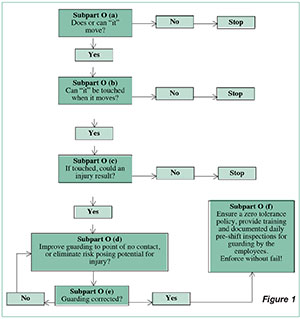Implementing a strong safety program involves a relatively thorough understanding of OSHA standards, with part of that understanding realizing you are dealing with minimum requirements. Another way to say this is you should have a thorough understanding of minimum requirements for a strong safety program.
Obviously, we can have a solid understanding of the minimum requirements.
The question then is will implementing minimum requirements yield a safety program that could be considered strong? The answer is obviously no. So, if we truly want to implement a strong safety program, just meeting minimum requirements is clearly not the answer — we must do more, we must go beyond compliance.
A strong safety program
So, what does a strong safety program actually consist of if not merely OSHA compliance?
Well, far too many line items exist to detail here, but few will argue that participation of the workforce is a critical element toward success. That, in and of itself, brings about significant challenges. While not insurmountable, a hurdle to this effort is training the workforce to a requisite level of understanding of an OSHA standard. Let’s face it, OSHA standards are not pleasurable reading, are very often confusing, and can take up a great deal of time — time that you do not have available — to navigate.
You must train your workforce and provide them with the knowledge and skills to effectively participate in your safety program. The question centers on the content of the training. Should that training be unpleasant reading, confusing, take up a great deal of time, and be difficult to navigate? Again, the obvious answer is no. So how can we address an OSHA standard, make it somewhat pleasant, remove the confusion, reduce the training time, and make it easy to navigate?
Subpart O (as an example)
I would like you to pause for just a moment before going forward. What can you tell me about Subpart O? Jot down a few points.
Unless you are exceptionally weird, here are a few things you did not write down: Subpart O contains 175,381 characters without spacing, and 218,066 with spacing for a grand total of 393,447 characters. Subpart O contains 2,197 separate paragraphs. It contains 3,758 individual sentences. “1910” is mentioned 796 times. “Shall” is mentioned 856 times. This is a large part of the problem; it adds to the confusion. There are many other little factoids that could be highlighted, but you get the point.
Does it really take all of this to tell you that the machine/equipment must be guarded? Can we do better? Can we virtually eliminate the confusion? Can we make it easier to train the workforce to better equip them to participate in our safety program? Can we make it easier to understand? Can we make it easy to navigate? Can we save ourselves valuable time?
Figure 1 serves to demonstrate that OSHA standards can be simplified, and at the same time, actually made stronger. Stronger, because when simplified, a greater percentage of the workforce can actually participate in the safety program with increased knowledge and skills. This ultimately yields a stronger safety program.
The following example serves to illustrate how OSHA standards might be simplified. In this example, Subpart O (machine guarding) is addressed. For ease of communication, a machine, equipment, etc. is expressed as “it.”
In the simplest terms: Does, or can, “it” move? If it does move, can it be touched? If it can be touched, can injury result? If the response to any of the above questions is yes, then steps should be taken to correct the machine guarding, no matter if the issue is an OSHA violation or not.
Proper machine guarding will assist in providing for a strong safety program. The overall program will be even stronger if you do it because it’s the right thing to do, not because it is an OSHA requirement.
The need for vigilance
The one statement we repeatedly hear from managers, supervisors and employees is, “You do not need to put a guard on that – a person would be foolish to put their hand in there!” When I hear that, I always come back with one question for them to answer: “Can you tell me of a time when someone had a body part crushed, or lost a body part in a piece of equipment from doing something smart?”
I’m only saying that employees, given the opportunity, will eventually place themselves in harm’s way by not making smart decisions. Of course employees are smart. That’s not the point. Oftentimes, the employee will believe they are doing the right thing, the right way. As safety professionals, we must recognize this and account for it in our overall program management, which includes machine guarding.
One final note, other OSHA standards can be addressed in the same manner as machine guarding shown in Figure 1.



